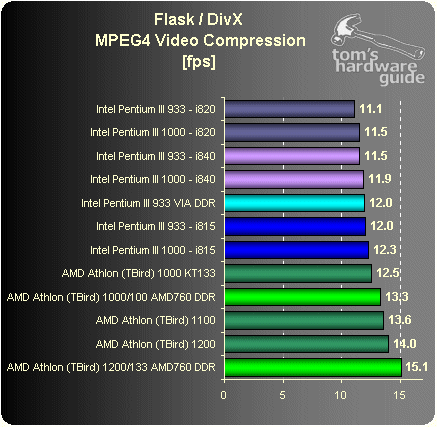DDR-SDRAM Has Finally Arrived
Flask / DivX - MPEG4 Encoding
I have added this new benchmark mainly out of own curiosity. The ones of you who are familiar with MPEG4 or who have read our articles about it will remember that there is hardly any other software right now that has such high requirements of the system performance. If you are using Word and Excel a lot, you will still not be able to notice a major system performance increase, because most of the time you are not waiting for your system, your system is waiting for you. I also doubt that a Quake 3 player would notice a difference between 150 and 180 fps. The story is very different for people who do a lot of MPEG4 encoding. Here each performance change is noticeable. Thus I consider this benchmark as one of the most meaningful. The procedure is very simple. I encode a short VOB-file with the latest Flask and DivX. To keep it simple I omit the audio encoding completely. Flask reports the time. Dividing the number of frames by the time it took to render the short film brings me the rendering frame rate I am looking for.
Again AMD760 with DDR is having quite a lead ahead of the KT133-system. The most surprising result of this benchmark however is the bad performance of the RDRAM-systems. Rambus and Intel were always preaching that RDRAM is the perfect 'streaming-memory'. Well, MPEG4-encoding is using a permanent memory stream and still RDRAM comes out worst. VIA's early VT8633 plus DDR SDRAM doesn't give a very good impression as well though. It's slower than i815 with PC133 SDRAM.
Get Tom's Hardware's best news and in-depth reviews, straight to your inbox.
